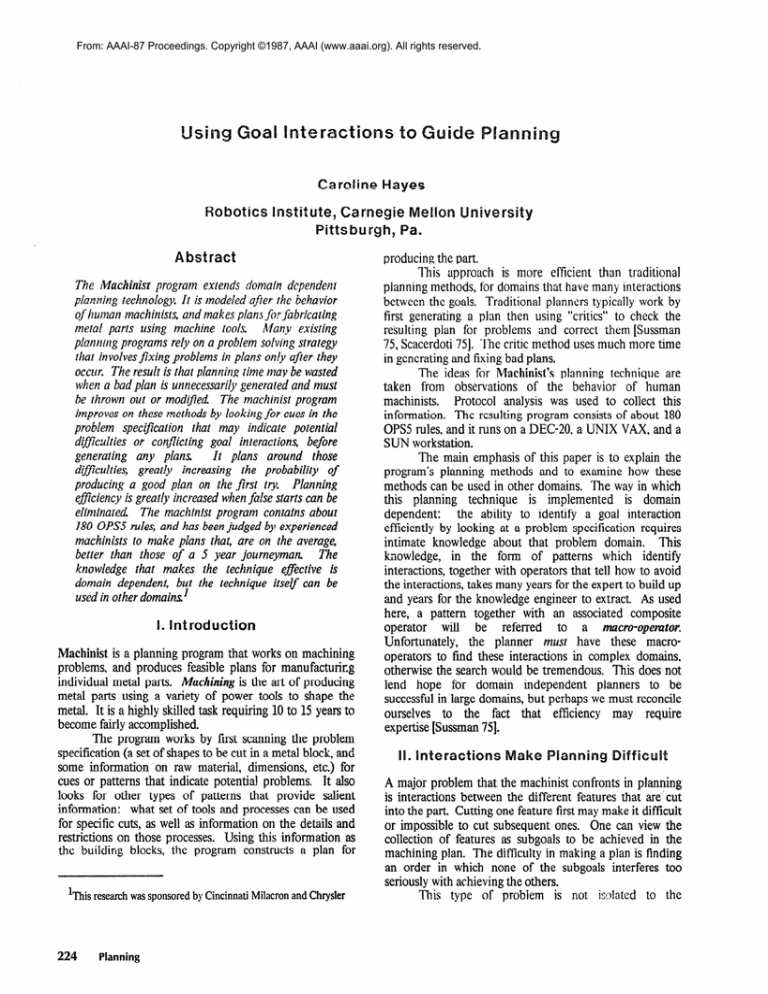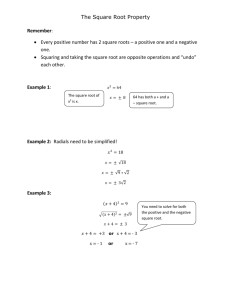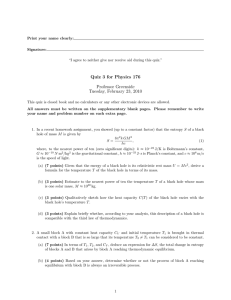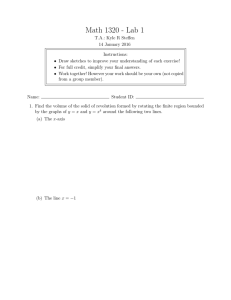
From: AAAI-87 Proceedings. Copyright ©1987, AAAI (www.aaai.org). All rights reserved.
Caroline
Robotics
Institute, Carnegie Mellon University
Pittsburgh,
Pa.
Abstract
The Machinisf program extends domain dependent
planning technology. It is modeled after the behavior
of human machinists, and makes plans *forfabricating
metal parts using machine tools. Many existing
plannmg programs rely on a problem solving strategy
that involvesfixing problems in plans only after they
occur. The result is that planning time may be wasted
when a bad plan is unnecessarily generated and must
be thrown out or modified The machinist program
improves on these methods by looking for cues in the
problem spect$cation that may indicate potential
dtfj?culties or conflicting goal interactions, before
It plans around those
generuting any plans.
di@ulties, greatly increasing the probability of
producing a good plan on the first try. Planning
ef$ciency is greatly increased whenfalse starts can be
eliminated The machinist program contains about
I80 UPS5 rules, and has been judged by experienced
machinists to make plans that, are on the average,
better than those of a 5 year journeyman, The
knowledge that makes the technique eflective is
domain dependent, but the technique itself can be
used in other domainst
I. Introduction
Machiiist is a planning program that works on machining
problems, and produces feasible plans for manufacturing
individual metal parts. Machining is the art of producing
metal parts using a variety of power tools to shape the
metal. It is a highly skilled task requiring 10 to 15 years to
become fairly accomplished.
The program works by first scanning the problem
specification (a set of shapes to be cut in a metal block, and
some information on raw material, dimensions, etc.) for
cues or patterns that indicate potential problems. It also
looks for other types of patterns that provide salient
what set of tools and processes can be used
information:
for specific cuts, as well as information on the details and
restrictions on those processes. Using this information as
the building blocks, the program constructs a plan for
‘This research was sponsored by Cincinnati Milacron and Chrysler
224
Planning
Hayes
producing the part.
This approach is more efficient than traditional
planning methods, for domains that have many interactions
between the goals. Traditional planners typically work by
first generating a plan then using “critics” to check the
resulting plan for problems and correct them [Sussman
75, Scacerdoti 751. The critic method uses much more time
in generating and fixing bad plans.
The ideas for Machinist’s planning technique are
taken from observations
of the behavior of human
machinists.
Protocol analysis was used to collect this
information.
The resulting program consists of about 180
OPS5 rules, and it runs on a DEC-20, a UNIX VAX, and a
SUN workstation.
The main emphasis of this paper is to explain the
program’s planning methods and to examine how these
methods can be used in other domains. The way in which
this planning
technique
is implemented
is domain
the ability to identify a goal interaction
dependent:
efficiently by looking at a problem specification requires
intimate knowledge about that problem domain.
This
knowledge, in the form of patterns which identify
interactions, together with operators that tell how to avoid
the interactions, takes many years for the expert to build up
and years for the knowledge engineer to extract. As used
here, a pattern together with an associated composite
croq
tar.
operator
will be
referred
to a
Unfortunately,
the planner
must have these macrooperators to find these interactions in complex domains,
otherwise the search would be tremendous. This does not
lend hope for domain independent
planners to be
successful in large domains, but perhaps we must reconcile
ourselves
to the fact that efficiency may require
expertise [Sussman 751.
II. Bnteractions
A major problem that the machinist confronts in planning
is interactions between the different features that are ‘cut
into the part. Cutting one feature first may make it difficult
or impossible to cut subsequent ones. One can view the
collection of features as subgoals to be achieved in the
machining plan. The difficulty in making a plan is finding
an order in which none of the subgoals interferes too
seriously with achieving the others.
This type of problem is not it;l:!lated to the
machining domain; interactions between subgoals have
been observed in many planning domains by many
researchers: Stefik [Stefik 811, Hammond [Hammond 863,
Sussman [Sussman
Tate [Tate
and
751,
761,
Carbonell [CarbonelI 811 to name a few. Sussman noted it
as early as 1973 in HACKER: “interactions between steps,
(are) a common cause of bugs.“2 Stefik perhaps, expressed
it best: “In planning problems, there are typically many
goals to be achieved in some order. The goals interact with
each other in many ways which depend both on the order
in which they are achieved and on the particular operators
which are used to achieve them.0V3 A feature interaction
happens when cutting one collection of features affects the
way in which others can be made. Cutting one set of
features may make it difficult to make other features latter
on in the process.
The methods used to make those
subsequent features may have to be changed, or all the
steps in the plan may have to be reordered so it is possible
to cut all of the features.
Feature interactions have several different causes.
Most commonly they result from clamping problems;
producing one feature destroys the clamping surfaces
needed to grip the piece while cutting another feature.
A feature interaction is shown below in figure 1.
This part has two features: an angle, and a hole. The angle
has been cut and the hole is about to be drilled, but when
the drill touches the angled surface it will slip sideways and
cause the hole to be placed inaccurately. The angle can be
said to interact with the hole. The solution is to drill the
hole first while the end of the part is still flat. Since the
hole does not affect how the angle is made, a simple
reordering prevents the features from interacting.
process. The human’s planning process is described in
[Hayes 871. The most important omission is that there is no
verification phase at the end of the program’s planning.
To demonstrate how the program works, let us
suppose one wanted to make the part in figure 2 from the
metal stock shown in figure 3. There are five features that
need to be cut into this part: three holes, an angle, and a
shoulder (a shoulder is any ledge-like shape cut out of a
side).
The part is. represented in the program as a
rectangular block from which features are subtracted. The
block of metal that it will be made from, the stock, is saw
cut and irregular on all sides.
Figure2: A partwith 5 features:
three holes, a shoulder, and an angle
~--~~~~~-~~-5,25
--~~~~-~--~~-~>
Figuie 3: The stock from which the part will
be made: saw cut on all sides
the drill
will slide
when it starts
to chill the
hole.
Figure I: Featare interaction: the hole
must be cut before the angle
II
The
planning
wist program is modeled after the human’s
process but it only implements a part of that
2
Gerald 9. Sussman, A Computer Model of Skill Acquisition,
American Elsevier Publishing Company, New York, 1975, MIT AI
Technical Report TR-297, August 1973,p. 119
‘Mark Stefik, “Planning and Me&Planning (MOLGEN: Part 2);’
Artificial Intelligence, voi 16, no. 2., 1981,p. 141.
The first task to be done is that the program must
identify the problems and interactions that occur in the
part. This gets the program oriented to the basic structure
and difficulties of the problem. Macro-operators are used
to identify the interactions and produce the corresponding
restrictions that they cause.
In this part there are three interactions. The first is
between Hole 3 and the angle. If the angle is made first it
will interact with the hole, by causing the drill bit to slip on
the slanted surface. This will make the hole placement
inaccurate, as shown in the previous section II. The
restriction that this interaction puts on the plan is that Hole
3 must be made before the angle.
The second interaction is between Hole 3 and the
shoulder: the hole must be made before the shoulder. If
the shoulder is made first, the part will be too thin and
floppy when it is clamped to cut the hole. The result of the
third interaction is that the angle must be made before the
shoulder, for similar reasons.
These three interactions: Hole 3 before Angle, Hole
3 before Shoulder, Angle before Shoulder, all restrict the
order in which the features can be cut. They can be put
Hayes
225
together into one interaction graph (shown in figure 4).
Each arrow represents one interaction.
a. Drill Hole 3
I
b. Mill Angle
Hole 3
before
shoulder
Angle gfore Shoulder
Ho1e 2
c. Mill Shoulder
The Final
Figure4: InteractibnGraphtthe order in which
the features may be cut
The next task is to retrieve a squaring graph from
memory. A squaring graph outlines all methods for getting
the raw material into a square and accurate shape with the
minimum waste of material. It represents the constraints
on the order in which each of the sides may be “squared
off.” It serves as a framework from which the feature
constraints can be hung.
The squaring graph for this example is shown in
figure 5. In each step, the shaded surfaces will be machined
smooth. Steps that are shown side by side as branches in
the graph can be done in either order: it does not matter
which side of a branch is done first.
side
Set-up C
Set-up D
Set-up E
Figure5: The Squaring Graph for squaring up a block
that is sawn on all sides
We now have a graph showing the orders in which
the features can be produced, and a graph showing the
Each graph
orders in which the sides may be cut.
represents a separate set of constraints on the plan. The
two must be merged with as much overlap between the
steps as possible, so that we get a compact sequence. The
more overlap the better, because the plan will be more
concise. The merging the two graphs is shown in figure 6.
Observe that between the Interaction Graph and the
Squaring Graph there are 8 steps, but in the final plan there
226
Planning
7. c
4. a.
Figure 6: Merging the Interaction Graph
with the Squaring Graph
are only 7. This is because we were able to combine step b
from the Interaction Graph with Set-up E from the
Interaction Graph. The details on the processes by which
squaring plans are chosen and the two graphs are merged is
described in wayes 871.
After producing the plan, the program does not go
through the final verification phase as the human does. If
all problems and goal interactions have been properly
identified, the plan wiZZ
be correct and the verification step
unnecessary.
However, the program would obviously be more
robust if it used a verification step as the human does. It is
not always possible to identify all problems beforehand:
neither the machinist nor the program can have a complete
set of patterns to identify absolutely all possible problems
and goal conflicts. Therefore, the plans produced will not
always be good the first time: there needs to be some sort
of a safety net to catch problems that initially escape notice.
Human machinists also use a “critic” approach, to check
the final plan for errors. They may reorder steps, or replan
to fix th;m. Future versions of the Machinist program will
also be able to do this.
Out of the 180 productions that comprise this system: 10
productions identify feature interactions and construct the
feature interaction graph, 39 identify other problem’s and
generate constraints not caused by interactions, 13 choose
the squaring graph, 44 merge the interaction graph with the
squaring graph, 11 generate the final plan from the merged
constraint graphs, and 63 enter and check data, infer
missing data, group features, push and pop goals, etc. The
first two categories which identify interactions and generate
constraints, are the ones that have the most room to grow.
Productions can be added to these two categories, greatly
increasing the range of parts that the system can handle,
while the rest of the system remains the same.
How much do the heuristics implemented by these
rules cut down the search space?
There are several
categories of heuristics used by the program:
feature
interactions, squaring graphs, and graph merging. If the
total effect of all the heuristics on the example used in this
paper is taken together, we find that they reduce the
number of plans that must be examined by a minimum
factor of 1,663,200 compared to search using no heuristics.
Let us now consider only the feature interaction
heuristic by itself. For the example part there are 5 features
but only 3 interactions.
For this case, the feature
interaction heuristic alone cuts down the number of plans
that must be examined by a factor of 10. If we look at a
more complicated example taken from [Hayes 873 that has
14 features and 5 interactions, the feature interaction
heuristic cuts down the number of plans examined by a
factor of 630,000.
Essentially, the more features and the more
interactions there are, the more difficult it is to find a good
plan. The problem is not that the search space gets larger as
more interactions are added, it is that the density of good
solutions in that space goes down.
The machinist’s
knowledge of feature interactions helps him to zero-in on
only those good solutions.
The program was tested against four machinists at various
experience levels: two second year apprentices, one third
and one journeyman
with 5 years
year apprentice,
experience including the apprenticeship.
Each of these
subjects was asked to create a machining plan for the same
series of three parts. Each part was apparently simple, but
contained difficulties when examined more closely.
Their resulting plans were judged by two very
experienced machinists, each having more than 15 years
experience. The average rating given to each of the four
subjects and the program are shown in figure 7. The
program’s average performance was better than that of the
In fact, Machinist 1
apprentices or the journeyman.
declared the program’s plan for Part III to be “Almost the
perfect plan. Who ever did this is a man after my own
heart.”
The judging was done in the following way: for each
of the three parts there were five plans generated, one fiorn
each of the four young machinists, and one from the
program. All information indicating who (or what) created
the plan was removed, and the the plans were presented to
the two experienced machinists.
Independently,
they
Total 5
rating
points:
4
3
I
0
2nd Year 2nd Year 3rd Year 5th Year Machinist
Appr. B Appr. A Appr.
Journey. Program
Figure7: Average Plan Rating for Each Subject
ordered each set of five plans, rating them from best %o
worst. The best plans were given a score of 5, and the,
worst, 1.
The machinists’ ratings agreed exactly for 8 of the
plans, differed by 1 point for 3, and more than one for 4.
However, neither machinist felt that @e other was wrong in
his ratings.
Both felt that the plans which they rated
differently were actually very close in quality.
u-k
Many pieces of this planning process have been described
before but not as one cohesive method. Virtually all of the
planners referenced in this paper recognize the importance
of goal interactions in planning, but their method of dealing
with this problem is different than
achinist’s. Typically
they do not foresee problems in the problem specification
and avoid them. lnstead they make plans with mistakes in
them and use critics to recognize and correct them after the
fact [Sussman 75, Scacerdoti 751. Time is wasted fixing and
replanning.
TWEAK [Chapman SS], and CARI [Descotte 811
both work by successively adding constraints to the
description of the solution. The interaction and squaring
are also constraints, but
graphs used by Machist
kf..chinnbf’s advance over this approach is to obtGn the
constraints as the result of feature interactions.
A number of chess strategy planners use macrooperators. They use patterns associated with plans to make
search more efficient. Interestingly, many of them have
been modeled, at least indirectly,, from human
Berliner and Campbell [Berliner 831, and De
Groot 651 all use some variant of this method but none of
them seem to consider the effect of goal interactions on
planning.
There are only a few programs that take goal
interactions into account before attempting a plan. One of
the earliest, Tate’s pate 761 planner for house construction,
does take interactions into account before it makes a plan.
Hayes
227
However, these interactions must be entered by a human
since the planner itself cannot determine what tasks
interact. A new set of interactions must be entered for each
new task.
This type of solution is not practical for
machining problems since each new problem contains a
different set of imeractions. One cannot reuse the same set
of interactions over and over again for a large class of
problems.
Wilenski’s planner, PANDORA [Wilensky 801, and
to some extent Wilkins planner,
SIPE [Wilkins 841
specifically look for goal interactions before planning
(which is a great advance in domain independent planning).
However, since it iS domain independent, it can not make
use of domain knowledge (in the form of patterns) to help
identify goal interactions quickly and to find a way around
them. Consequently, its performance on complex tasks
such machining problems would be impractically slow.
Chef [Hammond 861 is a planner that generates
recipes for Chinese cooking. It is one of the few planners
that looks at the problem description for cues to potential
problems and interactions.
However, it does not use the
interaction information to generate the plan as Machinist
does but only to retrieve and modify plans. This is a good
approach for many problems but it will not do for
machining. Small differences in the shape or size of a part
may make ‘big differences in the plan-so it is not good
enough to index a past plan for a part that looks similar,
and modify it. The plans may have so little similarity that it
is easier to construct a new plan from scratch.
References
Berliner, Hans: Murray Campbell. Using
[Berliner 831
Chunking to Solve Chess Pawn Endgames. Technical
Report CMU-CS-83-122, Carnegie Mellon University,
April, 1983.
[Carbone
Carbonell, Jaime G. Subjective
Understanding, Computer h4odels of Belief Systems. UMI
Research Press, Ann Arbor, Michigan, 1981. PHD Thesis,
Yale University, 1979.
[Chapman 851 Chapman, David. Planning for
Conjunctive Goals. Technical Report 802, Massachusetts
Institute of Technology, May, 1985.
De Groot 651 De Groot, A. D. Thought and Choice in
Chess. Mouton & Co., The Hauge, Netherlands, 1965.
Descotte, Y., J. Latombe. GARI: A
pescotte 811
Problem Solver that Plans how to Machine Mechanical
Parts. Proceedings of IJCAI :766-772,1981.
pammond
861 Hammond, Kristian J. CHEF: A Model
fo Case-Based Planning. AAAI-86 :267-271,1986.
VII. Conclusion
The difference between Machinist and other planners
that it has all of the following properties together:
Phyllis Huckestein
for contributing
their machining
expertise to this project: to Paul Wright, Jaime Carbonell,
Herb Simon, Irene Skupneiwicz, Paul Englert, Brack
Hazen; Gregg Lebovitz, Barbara Wright, Mark Perlin and
Mike Parzen for their advice, comments, and proof
reading; and to Ken Mohnkern for the art work. This
research was funded by Cincinnati Milacron and Chrysler.
is
1. a pre-planning
step in which it scans the
problem specification for signs of possible goal
interactions,
Hayes, Caroline C. Planning in the
[Hayes 871
Machining Domain: Using Goal Interactions to Guide
Search. Master’s thesis, Mellon College of Science,
Carnegie Mellon University, April, 1987.
[Scacerdoti 751 Sacerdoti, Earl D. The Nonlinear
of Plans. IJCAI4 :206-214,1975.
Nature
2. macro-operators to identify goal interactions,
and to suggest ways to restrict the plan so as to
avoid them,
[Stefik 811
Stefik, Mark. Planning and MetaPlanning (MOLGEN: Part 2). ArtzjicialInteZZigence
16(2):141-170,1981.
3. a plan constructed from collected information
rather then a plan that is indexed from memory
and modified.
Sussman, Gerald J. A Computer Model of
[Sussman 751
Ski22Acquisition. American Elsevier Publishing Company,
New York, 1975. MIT AI Technical Report TR-297,
August 1973.
In particular, the pre-planning
identification
of
problem areas can greatly increase planning efficiency
within a particular domain.
The macro-operators that
identify problem areas and suggest solutions are the key to
planning efficiency. The set of operators used must be
domain.dependent,
but the general strategy can be applied
to other domains.
Acknowledgements
I would like to extend a special thanks to Jim Dillinger,
Dan McKeel, Ken Pander, Steve Klim, Dave Belotti, and
22%
Planning
Tate, Austin. Project Planning Using a
pate 761
Hierarchic Non-Linear Planner. Technical Report D.A.I.
Research Report No. 25, University of Edinburgh,
University of Edinburgh, August, 1976.
[Wilensky 801
:334-336,198O.
Wilensky, Robert. Me&planning.
AAAI
[Wilkins 841
Wilkins, David E. Domain-independent
Planning: Representation and Plan Generation. Artzjicial
Intelligence :269-301,1984.





